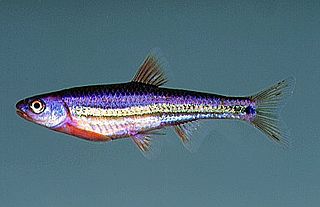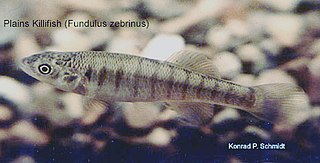
The Rio Grande, known in Mexico as the Río Bravo del Norte or simply the Río Bravo, is one of the principal rivers in the southwestern United States and in northern Mexico. The length of the Rio Grande is 1,896 miles (3,051 km). It originates in south-central Colorado, in the United States, and flows to the Gulf of Mexico. The Rio Grande drainage basin (watershed) has an area of 182,200 square miles (472,000 km2); however, the endorheic basins that are adjacent to and within the greater drainage basin of the Rio Grande increase the total drainage-basin area to 336,000 square miles (870,000 km2).

The Pánuco River, also known as the Río de Canoas, is a river in Mexico fed by several tributaries including the Moctezuma River and emptying into the Gulf of Mexico. The river is approximately 510 kilometres (320 mi) long and passes through or borders the states of Mexico, Hidalgo, Querétaro, San Luis Potosí, Tamaulipas, and Veracruz. According to the Atlas of Mexico, it is the fourth-largest river in Mexico by volume of runoff, and forms the sixth-largest river basin in Mexico by area.

Notropis is a genus of freshwater fish in the family Cyprinidae. They are known commonly as eastern shiners. They are native to North America, and are the continent's second largest genus.
Notropis aguirrepequenoi is a species of fish in the family Cyprinidae, the carps and minnows. Its common name is the Soto la Marina shiner. It is endemic to Mexico, where it occurs in the lower Rio Grande.
The Durango shiner is an extinct species of freshwater fish of the family Cyprinidae. It was found only in Mexico. The Durango shiner was native to the Rio Tunal, which forms the headwaters of the San Pedro Mezquital River, a Pacific slope river rising near Durango City, Durango, Mexico. It was taken there only in 1951 and 1961. Its closest relatives were the yellow shiner and the Ameca shiner.
The Rio Grande shiner is a species of ray-finned fish in the family Cyprinidae. It is found in Mexico and the United States.
The Salado shiner is an extinct species of ray-finned fish in the family Cyprinidae. It was found only in the Rio Salado, a tributary of the Rio Grande in northern Mexico. It was locally known as sardinita de salado.
The bluntnose shiner is a species of ray-finned fish in the family Cyprinidae. It was found in Mexico and the United States, but is now only known from the United States.

The Tamaulipan mezquital is a deserts and xeric shrublands ecoregion in the Southern United States and northeastern Mexico. It covers an area of 141,500 km2 (54,600 sq mi), encompassing a portion of the Gulf Coastal Plain in southern Texas, northern Tamaulipas, northeastern Coahuila, and part of Nuevo León.

The sand shiner is a widespread North American species of freshwater fish in the family Cyprinidae. Sand shiners live in open clear water streams with sandy bottoms where they feed in schools on aquatic and terrestrial insects, bottom ooze and diatoms.

The Texas shiner is a species of ray-finned fish in the genus Notropis. It is found in the Colorado River to Rio Grande drainage from Texas and northeastern Mexico and the Rio Salado and Rio San Juan systems in Mexico to the lower Pecos River in Texas.

The Arkansas River shiner is a species of ray-finned fish in the genus Notropis. It is native to part of the central United States. Historically this shiner was widespread and abundant throughout the western portions of the Arkansas River basin in Kansas, New Mexico, Oklahoma, and Texas. It is extirpated from the River in Kansas and Oklahoma. Recently, the species was almost entirely confined to about 820 km of the Canadian River in Oklahoma, Texas, and New Mexico, but it has been introduced and is now widely established in Pecos River in New Mexico.

The Tamaulipas shiner is a small North American freshwater fish, living in the Rio Grande drainage in Texas and northern Mexico.

The ghost shiner is a North American species of freshwater fish of the family Cyprinidae. It is generally characterized as being a small bodied, silvery and fusiform shaped cyprinid. Notropis buchanani is morphologically similar to and often mistaken for the Mimic Shiner, which is evident by its former classification as a subspecies of Notropis volucellus.

The yellow shiner is a species of ray-finned fish in the genus Notropis. It is endemic to Mexico where it is found in the Rio Lerma - Rio Grande de Santiago and Rio Pánuco in central Mexico. It forms a species complex within the genus Notropis with the Ameca shiner and the now-extinct Durango shiner.

The Chihuahua shiner is a species of freshwater ray-finned fish from the family Cyprinidae, the carps and minnows. It is found in southern Texas and northern Mexico.
The Ameca shiner is a species of cyprinid fish in the family Cyprinidae. The Ameca shiner was described in 1986 from upper parts of the Ameca River drainage in Jalisco, Mexico. Although already feared extinct by 1969, and listed as such by the IUCN when rated in 1996, a tiny population was rediscovered in 2001. Some were brought into captivity to form the basis of a breeding program. These have been used for a reintroduction project since 2015.

The blacktail shiner is a small freshwater fish in the family Cyprinidae native to the United States.

Fundulus zebrinus is a species of fish in the Fundulidae known by the common name plains killifish. It is native to North America, where it is distributed throughout the Mississippi River, Colorado River, and Rio Grande drainages, and other river systems; many of its occurrences represent happy introduced populations.

Notropis megalops, the West Texas shiner, is a species of freshwater ray-finned fish from the family Cyprinidae, the carps and minnows. It was originally described by the French ichthyologist Charles Frédéric Girard in 1856 but was thought to be a misidentification for the Texas shiner but detailed genetic and morphological studies have shown that N. megalops and N. amabilis are two valid but separate species. N. megalops has been found only in the drainage of the Rio Grande where it has a fragmented distribution and low levels of genetic diversity. Notropis megalops is endemic to the Rio Grande drainage of Texas and in Coahuila and Nuevo León in Mexico and does not overlap with N. amiabilis and despite their morphological similarity they do not appear to be closely related.














